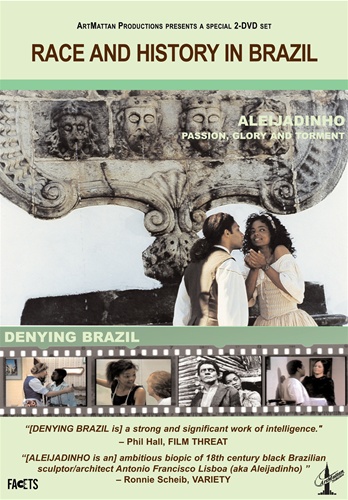The fallacy of racial pharmacogenomicsPosted in Articles, Health/Medicine/Genetics, Media Archive on 2012-05-12 04:36Z by Steven |
The fallacy of racial pharmacogenomics
Brazilian Journal of Medical and Biological Research
Volume 44, Number 4 (April 2011)
pages 268-275
DOI: 10.1590/S0100-879X2011007500031
S. D. J. Pena
Departamento de Bioquímica e Imunologia, Universidade Federal de Minas Gerais
Belo Horizonte, MG, Brasil
GENE – Núcleo de Genética Médica, Belo Horizonte, MG, Brasil
Personalized pharmacogenomics aims to use individual genotypes to direct medical treatment. Unfortunately, the loci relevant for the pharmacokinetics and especially the pharmacodynamics of most drugs are still unknown. Moreover, we still do not understand the role that individual genotypes play in modulating the pathogenesis, the clinical course and the susceptibility to drugs of human diseases which, although appearing homogeneous on the surface, may vary from patient to patient. To try to deal with this situation, it has been proposed to use interpopulational variability as a reference for drug development and prescription, leading to the development of “race-targeted drugs”. Given the present limitations of genomic knowledge and of the tools needed to fully implement it today, some investigators have proposed to use racial criteria as a palliative measure until personalized pharmacogenomics is fully developed. This was the rationale for the FDA approval of BiDil for treatment of heart failure in African Americans. I will evaluate the efficacy and safety of racial pharmacogenomics here and conclude that it fails on both counts. Next I shall review the perspectives and the predicted rate of development of clinical genomic studies. The conclusion is that “next-generation” genomic sequencing is advancing at a tremendous rate and that true personalized pharmacogenomics, based on individual genotyping, should soon become a clinical reality.
Introduction
The American astrophysicist Neil deGrasse Tyson defined the “perimeter of ignorance” as the boundary where scientists face a choice: continue the quest for knowledge or invoke a deity or other supernatural forces. He used as an example no less than Isaac Newton himself, whose law of gravity enabled calculation of the force of attraction between any two objects. When computing the orbits of the planets around the sun, Newton feared that the mutual attraction between them would render the solar system unstable. He then concluded that God occasionally stepped in to make things right. A century later, the French astronomer Pierre-Simon de Laplace created a new mathematical tool called perturbation theory and used it to demonstrate that the solar system is in fact stable over periods of time much longer than Newton could predict. Laplacian science, therefore, no longer needed to postulate the interference of supernatural forces to explain astronomical facts.
Newton’s appeal to God, however unnecessary, may at first sight appear as a humble attitude of a great man. However, Tyson demonstrates that, on the contrary, it represented presumptuousness on his part: if his mathematics was not good enough to explain the phenomenon, then the problem was too complicated for any other human mind to figure out, then or anytime in the future. By “embracing ignorance” Newton’s attitude negatively infused a temporary stage of incomplete knowledge with a false permanency, running counter to the philosophy of open-mindedness and discovery that characterizes Science.
Pharmacogenetics and pharmacogenomics are likewise in a dilemma right at the edge of the perimeter of ignorance…
…To try to deal with this situation it has been proposed to use interpopulational variability as a reference for drug development and prescription, leading to the development of “race-targeted drugs”, as exemplified by the case of BiDil for treatment of heart failure in African Americans. The rationale for such strategy is that, since we still lack the pharmacogenomic knowledge necessary to implement true personalized treatment, we make do by using the race or the ethnic-geographic affiliation of a given patient as the replacement of the germane individual genotyping at critical loci.
Therein lies the fallacy of racial pharmacogenomics – being predicated on the idea that individual genotyping will be impossible to achieve in the near future, it “embraces ignorance”. Moreover, it often does so under false premises. For instance, in the FDA news release entitled “FDA Approves BiDil Heart Failure Drug for Black Patients” it is stated that this represents “a step toward the promise of personalized medicine”. But racial medicine is group medicine – most definitely it is not personalized medicine…
…I propose that, rather than thinking about populations, ethnicities or races, we should focus on the unique genome of a particular individual, which is structured as a mosaic of polymorphic haplotypes with diverse genealogical histories. This shifts the emphasis from populations to persons. We should strive to see each individual as having a singular genome and a unique life history, rather than try to impose on him/her characteristics of a group or population. Under this model, ideas such as that of human races or “race-targeted drugs” become meaningless and vanish like smoke.
The safety of racial pharmacogenomics
The adoption of racial pharmacogenomics by the FDA has serious implications that extend much beyond the restricted limits of the medical arena. Thus, it has to be evaluated not only scientifically, but also within a historical, sociological and philosophical context.
In the past, the belief that human races had substantial and clearly delimited biological differences contributed to justify discrimination and was used to oppress and foment injustices, even within the medical context. The concept of race is still loaded with ideology and carries within it relationships of power and domination. It is similar to a banana peel: empty, slippery and dangerous.
Thus, our final conclusion is that racial pharmaco-genomics fails on grounds of insufficient benefit/cost ratio: it has much to recommend against it and very little scientific justification in its favor.
To use racial pharmacogenomics as a palliative measure is tantamount to “embracing ignorance”. It erroneously confers persistence and credence to the idea that human races do exist. As pointed out by the sociologist Paul Gilroy, such persistence is toxic, contaminating and weakens all society…
Read the entire article here.


